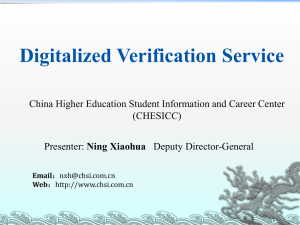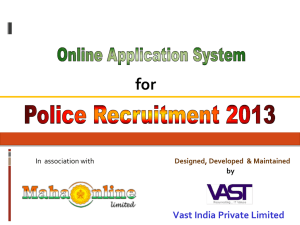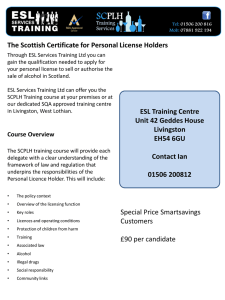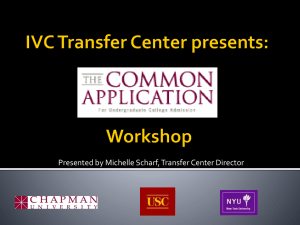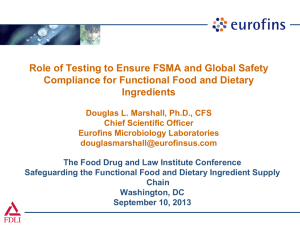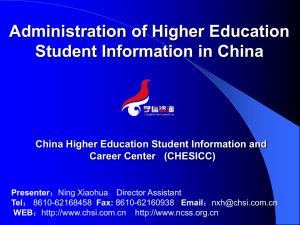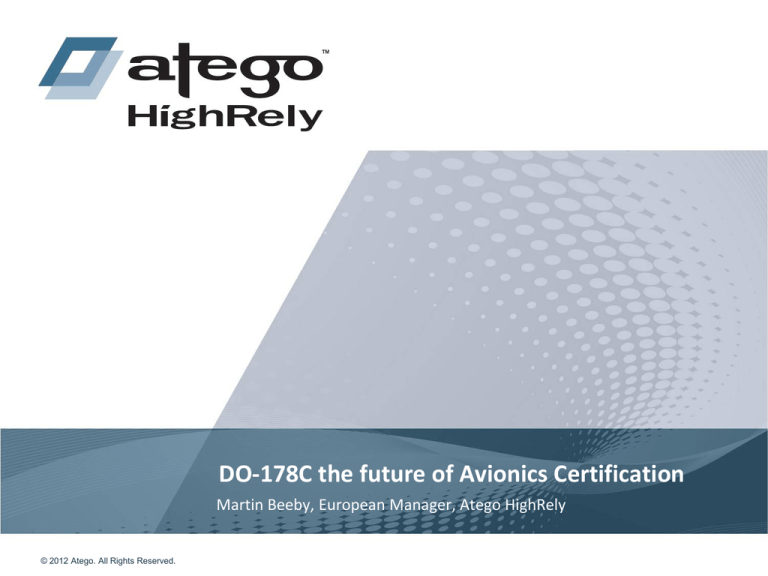
DO-178C the future of Avionics Certification
Martin Beeby, European Manager, Atego HighRely
©
© 2012
2012 Atego.
Atego. All
All Rights
Rights Reserved.
Reserved.
1
What is DO-178
RTCA DO-178: “Software Considerations in Airborne Systems and
Equipment Certification”
Developed by Industry and Government committees
Many compromises to satisfy different goals: “Consensus”:
•
Collective opinion or concord; general agreement or accord
[Latin, from consentire, to agree]
Not a recipe book or “How To” guide
Guidance not prescription
Lawyers versus Software Engineers; who wins?
© 2012 Atego. All Rights Reserved.
2
DO-178: Evolution History
Doc
Year
Basis
DO-178
1980-82
498 & 2167A Artefacts, documents, traceability,
testing
DO-178A
1985
DO-178
Processes, testing, components,
four criticality levels, reviews,
waterfall methodology
DO-178B
1992
DO-178A
Integration, transition criteria,
diverse development methods,
data (not documents), tools
DO-178C
2012
+Supplements.
DO-178B
Reducing subjectivity; Address
MBD,OO, tools, Formal methods,
etc.
© 2012 Atego. All Rights Reserved.
Themes
3
Avionics Safety History: 1946 - 2008
© 2012 Atego. All Rights Reserved.
4
Safety: the precursor to DO-178
© 2012 Atego. All Rights Reserved.
5
Safety, System, Software & Hardware
Safety
Assessment
ARP 4761
System Development
• Architecture
ARP 4754
• Criticality Level
SW Rqmts
© 2012 Atego. All Rights Reserved.
HW Rqmts
Tests
Tests
Software
DO-178
Hardware
DO-254
6
Functional Safety
The Functional Safety framework surrounding DO-178 similar to:
⁻
IEC 61508 – Industrial systems development
⁻
ISO 26262 – Automotive systems development
⁻
EN 51208 – Railway systems
⁻
IEE 7-4.3.2 – Nuclear Power Systems
Objective based guidance gives development freedom with compromising
the use of new technology.
© 2012 Atego. All Rights Reserved.
7
Why change DO-178B
Almost 20 years since DO-178B released
Software Development landscape has changed ...
Advancements in:
-
Tools & automation
-
Modelling & Simulation
-
Object Oriented Technology
-
Formal Methodologies
Commercial world has embraced the above; Avionics has slowly followed
Alternate Means of Compliance does not provide a consistent mechanism
for certification
© 2012 Atego. All Rights Reserved.
8
DO-178C
Since 2005, committees have met to discuss, and update, DO-178B
Like 178B, included Industry & Agencies
Unlike 178B, more Tool Vendors
Obvious focus on “acceptability” of certain types of tools, particularly
“theirs”
Predominantly America & Europe, nearly equal; quarterly meetings
© 2012 Atego. All Rights Reserved.
9
DO-178C : Seven “Sub-Groups” (SG’s)
SG1: Document Integration
SG2: Issues & Rationale
SG3: Tool Qualification
SG4: Model Based Design (MBD) & Verification
SG5: Object Oriented (OO) Technology
SG6: Formal Methods (FM)
SG7: Safety Related Considerations (and ground-based systems)
© 2012 Atego. All Rights Reserved.
10
DO-178C
Unlike the DO-178A to DO-178B update, the “core” update to 178C is
modest
Instead, changes are handled via four “Supplements”, which “clarify”:
-
Tools Supplement
-
MBD Supplement
-
OO Supplement
-
FM Supplement
© 2012 Atego. All Rights Reserved.
11
Deliverables
DO-178C/ED-12C
Software Considerations in Airborne Systems and Equipment Certification
DO-248C/ED-94C
Supporting Information for DO-178C and DO-278A
DO-278A/ED-109A
Software Integrity Assurance Considerations for Communication, Navigation,
Surveillance and Air Traffic Management (CNS/ATM) Systems
DO-330/ED-215
Software Tool Qualification Considerations
DO-331/ED-216
Model-Based Development & Verification
DO-332/ED-217
Object-Oriented Technology Supplement
DO-333/ED-218
Formal Methods Supplement
© 2012 Atego. All Rights Reserved.
12
Software Tool Qualification Considerations (D-330)
Tool Qualification Considerations is a stand alone document that is
consistent with and follows the structure of DO-178C
It recognizes that tools occupy their own domain
⁻
They are not airborne software
⁻
Tool qualification can apply to hardware and ground-based systems also
DO-330 is a stand-alone approach to tool qualification that could be called
out by any standard
⁻
Domain Specific Guidance in the calling document
⁻
Tool qualification guidance from DO-330 based on crteria defined in the
domain specific guidance
© 2012 Atego. All Rights Reserved.
13
Same Basic Tool Qualification Principles
The tool qualification is unchanged from DO-178B:
⁻
The purpose of the tool qualification process is to ensure that the tool
provides confidence equivalent to that of the process(es) eliminated, reduced,
or automated
⁻
The higher the risk of a tool error adversely affecting system safety, the higher
the rigor required for tool qualification
Determining if tool qualification is needed, or unchanged from DO-178B:
⁻
“…when processes of this document are eliminated, reduced, or automated
by the use of a software tool without its output being verified as specified…”
© 2012 Atego. All Rights Reserved.
14
DO-178C Tool Qualification Levels
DO-178B Development and Verification Tools terminology is no longer
used. DO-178B Definitions:
⁻
Development Tools: whose output is part of airborne software and thus can
introduce errors
⁻
Verification Tools: that cannot introduce errors but may fail to detect them
DO-178C identifies 5 Tool Qualification Levels (TQL1-5) based on 3 criteria
(see next slide):
⁻
For criteria 1 and 3, the basic concept and required objectives are similar to
that applied under DO-178B
⁻
New criterion 2 introduced to provide increased objectives for certain tool
usage scenarios
© 2012 Atego. All Rights Reserved.
15
Advantages of Model-Based Development (DO-331)
Early animation of requirements
Shared language between systems and software engineers
Increased responsiveness to requirements changes
Ability to use autocode and simulation as a means of verification
© 2012 Atego. All Rights Reserved.
16
Model Based Development Supplement (DO-332)
Provides additional guidance for Model Based Development Technology
and Related Techniques
The MBD Supplement provides a set of approaches that can encompass
most organisations uses of MBD
⁻
A Framework for using MBD is established
⁻
Guidance on where certification credit for model simulation is provided
⁻
Core techniques of DO-178C are maintained in MBD
⁻
⁻
⁻
⁻
Requirement Levels
Requirement Based Testing
Traceability
Structural Coverage
© 2012 Atego. All Rights Reserved.
17
Object-Oriented Supplement (DO-332)
Provides additional guidance for Object-Oriented Technology and Related
Techniques
Much of the DO-178C OOT Supplement is devoted to establishing core
terminology, background and interpretation
⁻
Few additional objectives or activities are identified
Additional OOT objectives:
⁻
Verify local type consistency
⁻
Verify the use of dynamic memory management is robust
© 2012 Atego. All Rights Reserved.
18
Criteria for choosing whether to use OOT
Project technical criteria:
⁻
Potential benefit from increased expressive power in design/code –
encapsulations, class hierarchies and polymorphism
⁻
Nothing new here… these were original drivers behind OOT
Environmental criteria:
⁻
Guidance, Human Resources, Tools
⁻
In industry these are all currently available…
Summary:
⁻
OOT is a viable technique if the software design would benefit from its
expressiveness
© 2012 Atego. All Rights Reserved.
19
Formal Methods Supplement (DO-333)
DO-178B allowed for consideration of formal methods as an alternate
method “to improve the specification and verification of software”
Included a set criteria to determine the requirements to which formal
methods could be applied
⁻
Safety related
⁻
Definable by discrete mathematics
⁻
⁻
⁻
⁻
⁻
Involved complex behavior
Concurrency
Distributed processing
Redundancy management
Synchronization
© 2012 Atego. All Rights Reserved.
20
Formal Methods Supplement
The formal methods supplement applies where formal methods analysis is
replacing testing evidence in the submission
There is no intent to suggest that formal methods adoption is an “all in”
decision
⁻
Can be a selective adoption/migration for subsets of the system
The supplement mimics the core DO-178 document structure
Does not preclude traditional software testing even when comprehensive
formal methods are applied
© 2012 Atego. All Rights Reserved.
21
DO-178C Supplements Summary: Changing the Level of Abstraction
There is an underlying synergy between the new DO-178C documents and
supplements:
⁻
Object Oriented Technology (OOT), Model Based Design and Verification
(MBDV), Tools, Formal Methods
All are moving in a common direction:
⁻
Still enforce the objectives of DO-178C
⁻
Enable systematic verification and/or increased level of abstraction
⁻
Enabling more powerful development techniques to tackle the issues of
increased complexity and limited resources
Fundamental approach of DO-178 remains intact
© 2012 Atego. All Rights Reserved.
22
DO-178C: The Future
DO-178C will be mandated by EASA, FAA, and others at some time in the
future.
⁻
When?
⁻
But it will be mandated!
The model of providing Technology Supplements will be applied to future
standards
⁻
Maintain a core approach
⁻
Enable approaches for new technologies to be added
⁻
Be able to react more quickly by just adding supplements
© 2012 Atego. All Rights Reserved.
23
DO-178C: The Future
How will DO-178C affect systems development?
How did DO-178B affect systems development?
⁻
No specific life-cycle model required
⁻
Say what you are going to do
⁻
Do it
⁻
Show the evidence you did it
Analogous to ISO 9001, or CMMI
Good Engineering Practice
© 2012 Atego. All Rights Reserved.
24
SEI CMMI Maturity Levels
Level 1
SEI CMMI’s 5 Levels:
Level 2
⁻
Initial
Level 3
⁻
Repeatable (disciplined)
Level 4
⁻
Defined (consistent))
Level 5
⁻
Managed (predictable)
⁻
Optimizing (continuous improvement)
Each level is a perfect superset of the
preceding level
© 2012 Atego. All Rights Reserved.
25
Perfection
DO-178 Quality/Cost
100 % Perfection
Robust. Testing
Functional Testing
Unit Testing
Code Reviews
26
© 2012 Atego. All Rights Reserved.
Detailed Rqmts
Plans & Processes
CO$T
DO-178C: The Future
By Enabling new technologies it is possible to reduce the cost of
development
⁻
Reduced Time of Development
⁻
Ability to increase system capabilities
⁻
Reduce Obsolescence
Fundamental Safety approach is not compromised
⁻
Functional Safety Framework remains
⁻
Core approaches of DO-178 remain
⁻
New technologies have to fit within this framework
© 2012 Atego. All Rights Reserved.
27


